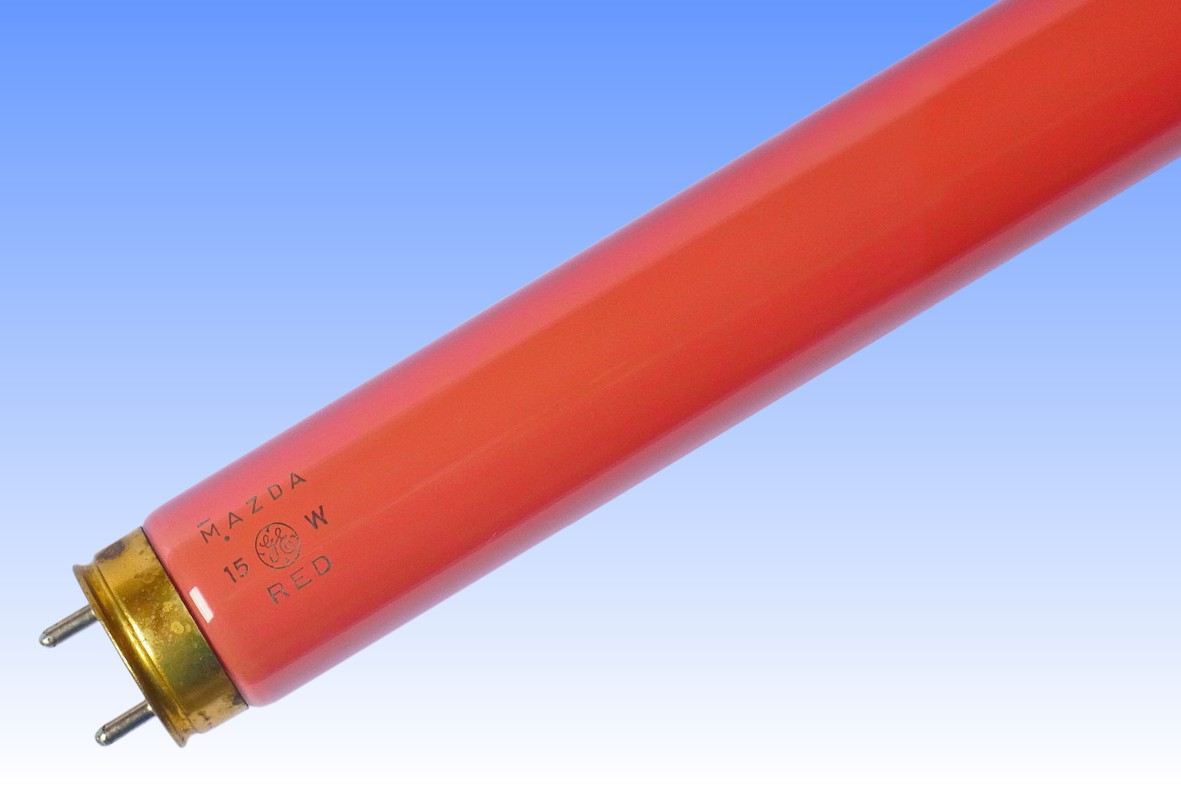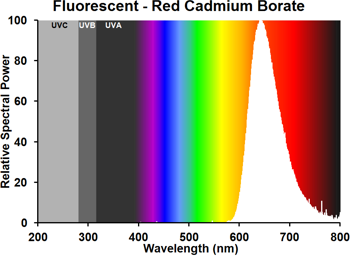
|
Fluorescent Red with Cadmium Borate Phosphor |

The fluorescent colours however were considerably more efficient than filtered incandescent lamps. As such it was considered that the primary application of fluorescent lamps would be in architectural and decorative applications, alongside the 'Lumiline' linear incandescent lamps that the company had pioneered in 1934. As such the fluorescent lamp was launched not only in white and daylight, but five additional colours of blue, green, gold, red and pink.
Blue light was produced with calcium tungstate phosphor, green with zinc silicate, and pink with cadmium borate. Gold was achieved with a zinc-beryllium-silicate modified to a yellower hue, combined with a pigment filter to remove shorter wavelengths. For many years the reddest fluorescing material was cadmium borate, whose emission peaks at about 615nm but is rather broad, extending into the yellow and green. To achieve a saturated colour this lamp has been first coated with a red pigment, and then with the phosphor. Its net efficacy is only about 3 lm/W - but this is still at least twice as good as a red incandescent lamp. In the 1940s cadmium borate was superseded by a redder formulation of zinc beryllium silicate, and then again by a brighter halophosphate combined with the red pigment.




| Manufacturer: | General Electric Co. of U.S.A. | |
| Lamp Power: | 15 Watts | |
| Lamp Current: | 0.300 Amps | |
| Lamp Voltage: | 56 Volts | |
| Cap Type: | G13 medium bi-pin | Brass |
| Bulb Type: | T-26 | T-8 in eighths/inch |
| Bulb Finish: | Red | 2CdO.B2O3:Mn + dye |
| Electrodes: | Coiled-Coil | (Ba,Sr,Ca)CO3 emitter |
| Discharge Length: | 394 mm | 15.5 inches |
| Atmosphere: | Hg | Ar | |
| Luminous Flux: | 45 lm (@ 100h) | |
| Luminous Efficacy: | 3.0 lm/W (@ 100h) | |
| Maximum Brightness: | 360 lux | 160 foot-lamberts |
| Chromaticity Co-ordinates: | CCx: 0.697 | CCy: 0.303 |
| Dominant Wavelength & Saturation: | 623 nm | 99% |
| Rated Lifetime: | 1500 hours | |
| Warm-up & Re-strike Time: | 2 minutes | Instant |
| Burning Position: | Universal | |
| Nominal Length: | 457 mm | 18 inches |
| Factory: | Jackson MI / Bucyrus OH | U.S.A. |
| Date of Manufacture: | 1941 4th Quarter | |
| Original Value: | ||
